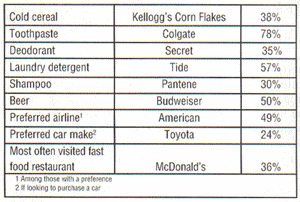Editor's note: Felipe Korzenny. Ph.D.. Betty Ann Korzenny, Ph.D., Rebecca Abravanel, Ph.D., and Adrien Lopez Lanusse are all senior research personnel at Hispanic & Asian Marketing Communication Research, Belmont. Calif.
Take a look at the table below. It shows the percentages of Spanish-dominant female heads of household who reported having in their home the brands in selected product categories. Respondents also were asked about their preferred airline, car make and fast food restaurant. Any surprises?
 The data are based on findings from 900 telephone interviews with randomly selected respondents as part of the quarterly omnibus of Spanish-dominant female shoppers in Los Angeles, New York City and Miami.
The data are based on findings from 900 telephone interviews with randomly selected respondents as part of the quarterly omnibus of Spanish-dominant female shoppers in Los Angeles, New York City and Miami.
The brands that followed each of the above had a substantially lower share. What made the brands shown above their category leaders? Those with the largest share tend to be the ones with the more extensive Spanish-language advertising programs. Since Spanish-dominant consumers tend to be relatively recent immigrants, they strongly rely on advertising to guide their purchase decisions.
These consumers tend to see Spanish-language advertising as information that helps make sense of the confusing array of products available to them. Since few brands have decided to concentrate on the Spanish-language market, those who show an interest reap the rewards.
But there is more than just advertising. Tradition from Latin American countries seems to contribute to brand preferences. After immigration to the U.S., many Hispanic consumers remain loyal to the brands they grew accustomed to in their countries of origin.
Colgate is a good example. Colgate is the traditional toothpaste par excellence in many Latin American countries. Colgate red or Colgate rojo. aided by its Spanish-language advertising emphasis in the U.S., maintains and reinforces the tradition it established long ago.
There are products that are truly ingrained in the lifestyles and world-views of I,atin Americans in the U.S. Kellogg's Corn Flakes is an example. Its prevalence in Latin America and its Spanish ad efforts in the U.S. seem to reinforce the synergy of its strong imagery and consumer following. Tide's strength seems to also be the result of heritage and U.S. communication efforts.
The chart above is full of examples of brands that have claimed their dominance mostly based on their strong Spanish-language advertising efforts in the U.S. They exemplify the great power of Spanish-language advertising to a market that appreciates being communicated with.
The moral of the story is: The Hispanic market is dominated by a small and select number of brands. Hispanic consumers tend to be less cynical about marketing and advertising than their general market counterparts. Opportunities exist to expand the range of choices available to these consumers. Marketers that have been loyal to this market seem to have derived just rewards.
